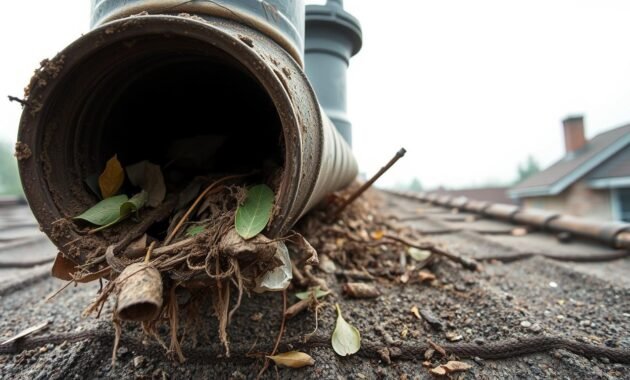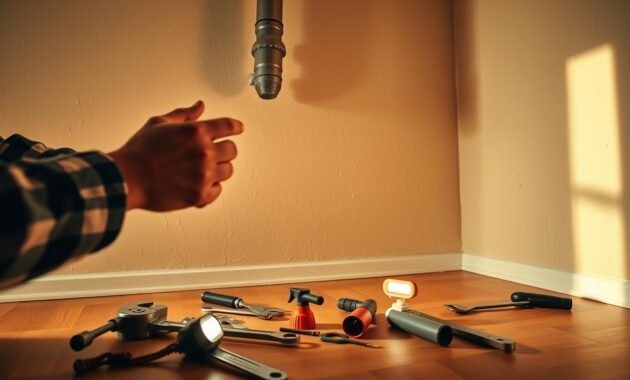Are you hearing strange gurgling sounds in your plumbing or noticing slow drains? Clogged vent pipes can make your plumbing system a real challenge. They can cause annoying blockages and even health risks. Cleaning your roof vents is not just a routine task. It’s essential for keeping your home’s drainage system working well.
I’ll show you how to tackle clogged vent problems to avoid costly repairs. You might face issues like debris, animal nests, or weather damage. This detailed guide will help you fix vent pipe problems fast and right.
Understanding Plumbing Vent Systems and Their Function
Plumbing vent systems are key to keeping your home’s plumbing in top shape. Knowing about roof pipe maintenance helps spot plumbing problems early.
These systems are vital for managing air pressure and ensuring water flows well. Without them, your plumbing could face big problems.
How Plumbing Vents Regulate Air Pressure
Understanding air pressure is the first step in vent pipe troubleshooting. Water moving through pipes creates a vacuum that can slow down water flow. Plumbing vents help manage this pressure:
- Prevent suction and negative pressure in pipes
- Allow air to enter the plumbing system
- Facilitate smooth drainage
The Role of P-traps in Ventilation
P-traps are key for keeping air flowing and stopping sewer gases. They create a water seal that keeps out bad smells and gases, while letting air in.
Why Roof Vents Are Essential for Home Safety
Roof vents do more than just hold up the roof. They keep your home safe by:
- Preventing gas buildup
- Reducing moisture-related damage
- Maintaining optimal indoor air quality
| Vent System Component | Primary Function | Importance |
|---|---|---|
| Vent Pipe | Air Pressure Regulation | Critical for Drainage |
| P-trap | Gas Blockage | Prevents Odors |
| Roof Vent | Exterior Air Exchange | Ensures System Efficiency |
Understanding these systems helps you keep your plumbing in good shape. This prevents future problems.
Common Signs of a Clogged Vent Pipe

Spotting blocked vent signs early can prevent expensive plumbing fixes. When your home’s ventilation system gets clogged, you’ll notice certain symptoms. These signs mean you need to fix airflow blockages.
Understanding the warning signs your home gives is key. These signs might seem small at first. But, ignoring them can lead to bigger problems.
- Slow-draining sinks and toilets
- Persistent foul odors throughout your home
- Unusual gurgling sounds in drain pipes
- Bubbling water in toilet bowls
- Sudden changes in water pressure
The most important signs include odd behaviors in bathroom and kitchen drains. Without proper air flow, water can’t move smoothly. This causes noticeable problems.
| Symptom | Potential Vent Blockage Indication |
|---|---|
| Gurgling Sounds | High likelihood of partial vent obstruction |
| Slow Drainage | Significant airflow restriction |
| Sewer Odors | Complete or near-complete vent blockage |
Experts say to check roof vent pipes often to avoid these issues. Catching and fixing airflow problems early keeps your plumbing system working well. This prevents bigger damage.
How to Unclog Vent Pipe on Roof: Step-by-Step Guide
Dealing with a clogged roof vent can be tough. But, with the right tools, you can fix it yourself. I’ll show you how to unclog your roof vent. This will help keep your home well-ventilated and avoid plumbing problems.
- Plumber’s snake or electrical fish tape
- Garden hose
- Safety harness
- Non-slip shoes
- Work gloves
- Flashlight
Safety Precautions Before Starting
Roof work is risky. Always put safety first when unclogging vents. Check the weather and roof slope before starting. If it’s too steep or slippery, call a pro.
Professional Cleaning Techniques
Here’s how to inspect and clean your roof vent:
- Make sure your ladder is stable and wear non-slip shoes
- Use a plumber’s snake to reach and break up the clog
- Insert the snake into the vent pipe carefully
- Rotate and push the snake to clear debris
- Flush out any remaining blockages with a garden hose
If clogs keep coming back, you might need a pro. It’s wise to know when to call for help. This prevents damage to your roof.
Read also: Paint to Stop Condensation on Metal Roof
Indoor Methods for Clearing Vent Pipe Blockages

Not everyone is comfortable climbing roofs to fix vent pipes. Luckily, you can solve these problems safely from your attic. These methods are best for PVC pipe systems.
Before you start, find the right pipe. PVC is good for indoor fixes, but cast iron might need a pro. Here’s what to do first:
- Find the vent pipe in your attic
- Make sure you have enough space to work
- Check if the pipe is PVC
- Get the tools you need for plumbing repair
To clear vent pipe sections indoors, use tools like a plumber’s snake or air canister. These tools can remove blockages without needing to go on the roof. Begin by cutting a small part of the PVC pipe to see and clear any clogs.
Always keep safety in mind when fixing pipes indoors. Wear protective gear, work in a well-ventilated area, and get help if you’re not sure or if it’s a tough blockage.
Identifying Different Types of Vent Pipe Obstructions
Detecting plumbing issues early can save homeowners a lot of time and money. Vent pipe obstructions come in many forms. Each one presents its own challenges for keeping airflow right in your home’s plumbing system.
When I check plumbing systems, I find several common blockages. Homeowners should look out for these signs. Knowing about these obstructions helps avoid drainage and air pressure issues.
Natural Debris and Weather-Related Clogs
Tree branches over your roof can cause big problems. Leaves, twigs, and other organic stuff can pile up inside vent pipes. This can lead to blockages.
- Wet leaves can quickly compress and create dense blockages
- Fallen branches may partially or completely obstruct vent openings
- Rainstorms can wash additional debris into vulnerable vent pipes
Animal Nests and Related Issues
Wildlife can make your vent pipes their homes. Small animals like birds, squirrels, and rodents often nest there. These nests block air circulation completely.
- Birds often build nests in roof vent openings
- Rodents can squeeze through small openings
- Nesting materials rapidly accumulate and restrict airflow
Ice and Snow Blockages
Cold climates bring special challenges for vent pipe care. Ice and snow can turn into solid blockages. These blockages stop proper ventilation.
- Freezing temperatures cause moisture to solidify inside pipes
- Snow accumulation can completely seal vent pipe openings
- Repeated freeze-thaw cycles increase blockage risks
Regular checks and proactive care are key to avoiding these common blockages. Being proactive ensures your plumbing system works well all year.
Preventive Maintenance Tips for Roof Vent Pipes
Keeping your home’s plumbing system safe starts with good roof pipe care. As a homeowner, I’ve found that stopping vent pipe problems early saves a lot of money. Regular checks on your roof vents can really help.
Fixing vent pipe issues starts with being proactive. Here are some ways to keep your roof vents working well:
- Schedule annual roof vent inspections
- Trim nearby tree branches that could drop debris
- Install high-quality vent pipe caps
- Check for animal nesting around vent openings
- Ensure proper pipe sizing for your home’s plumbing system
Keeping your vent pipes safe needs regular effort. I suggest making a seasonal maintenance plan. In fall and winter, watch out for leaves, snow, and ice. Spring and summer are great for detailed roof vent checks and cleanings.
Roofers advise using mesh screens on vents to keep out debris and animals. These screens let air in but block stuff that could clog. Choose durable materials that can handle different weather and protect your plumbing for a long time.
Good roof pipe care is more than just avoiding clogs. It’s about making sure your whole plumbing system works well and safely. A bit of prevention can save you from big repair costs and health risks.
Understanding Health Risks of Blocked Vent Pipes
Blocked vent pipes can pose serious health risks in your home. Many homeowners don’t realize this. When these pipes get blocked, harmful sewer gases can leak into your living areas. This can be very dangerous for your family’s health.
It’s important to spot plumbing problems early. Sewer gases contain harmful substances, with methane being the biggest worry. This gas is colorless and odorless but can cause serious health issues if ignored.
- Headaches and dizziness
- Nausea and respiratory irritation
- Potential long-term exposure risks
- Increased risk of bacterial growth
Hydrogen sulfide, another harmful gas, can cause even worse symptoms. When I check for plumbing vent repair needs, I stress the need to recognize signs of blockages. These signs can warn of health dangers.
Being exposed to these gases can lead to serious breathing problems. People with asthma or allergies might react more severely. Mold and bacteria can also grow in blocked pipes, adding to health risks for your family.
Getting a professional to inspect and fix your plumbing vents is key to a safe home. Regular upkeep stops these gases from building up. It keeps your family healthy.
Tools and Equipment for DIY Vent Cleaning
When cleaning roof vents, the right tools are essential. They help you clear blockages and ensure good airflow. As a DIY fan, I know that being prepared is important.
To unclog vents, you’ll need some key tools. Here’s a list of what you should have:
- Plumber’s snake or auger (primary tool for removing clogs)
- Garden hose with adjustable nozzle
- Flashlight or inspection camera
- Protective gloves and safety glasses
- Extendable ladder
- Wire brush for cleaning
The plumber’s snake is a must-have for cleaning roof vents. It can reach deep into pipes to remove clogs. Start with gentle pressure and increase as needed to avoid damage. If the snake doesn’t work, a garden hose can help flush out the rest.
Read also: How To Clean Roof and Gutter With Roof Rake for Leaves?
Always prioritize safety when cleaning vents. Wear shoes with good grip, use a strong ladder, and never work alone. If you’re unsure, consider using a safety harness.
Pro tip: For tough clogs, try using an electrician’s fish tape instead of a plumber’s snake. It’s more flexible and can get into tight spots better.
Conclusion
Keeping your home’s plumbing system in check is easier than you think. I’ve shown you how to tackle vent pipe clogs and spot problems early. Knowing how to clean roof vents can save you a lot of time and money.
Most homeowners can fix clogged vents on their own. You can handle debris, animal nests, or weather damage with the right techniques. But, for bigger issues, you might need a pro.
Regular checks and upkeep are vital for your home’s ventilation system. Being proactive helps avoid bigger problems. Trust your gut, but know when to get expert help.
Your home’s plumbing is complex and needs care. Now you’re ready to face most vent pipe problems head-on. Stay alert, act fast, and your home’s ventilation will stay in top shape for years.




